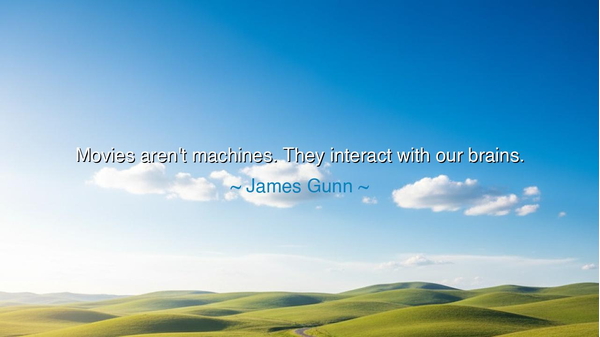
Movies aren't machines. They interact with our brains.






Hear the words of James Gunn, storyteller of modern myth, who declared: “Movies aren’t machines. They interact with our brains.” In this utterance he strikes at the heart of art itself, reminding us that cinema is not a lifeless mechanism, not a string of moving images wound upon a reel. It is a living dialogue between creation and consciousness, a force that shapes us even as we gaze upon it. In his words is revealed the ancient truth: that stories are not dead things, but companions that dwell in the soul, stirring memory, thought, and feeling.
The meaning of this saying lies in the sacred exchange between image and mind. A machine runs without care for who watches it; it hums, it turns, it produces. But a movie, like a tale told by firelight, is not inert. It breathes when we watch it. It feeds upon our fears, our desires, our hopes, and gives them back to us in the form of characters, conflicts, and visions. Thus the art of film is a mirror and a spark: a mirror that reflects our own humanity, and a spark that ignites within us feelings we did not know were sleeping.
Consider the example of Schindler’s List, a film that is more than mere scenes upon a screen. It reaches into the depths of memory and history, pressing upon our hearts the weight of human cruelty, yet also the flickering strength of compassion. No machine could do this; no lifeless device could make the soul tremble and weep as millions did upon seeing that little girl in red, or the names written upon the list. This is the power Gunn speaks of: movies are not metal and motion, but encounters between human imagination and human spirit.
The ancients, though they had no cinema, knew well the same principle. The plays of Sophocles and Euripides in the Theater of Dionysus were not machines of entertainment; they were forces that interacted with the mind of the polis. As the citizens watched Oedipus fall or Medea’s wrath unfold, they were not idle. They were tested, shaken, and taught. They carried those lessons into their homes and their politics. So too today, when we step into the darkness of the theater, we enter not a factory of images but a chamber of transformation.
The lesson for us is clear: treat art not as a product, but as a dialogue. A movie, a play, a book—they are not machines to be consumed mindlessly. They are voices, speaking to the deepest chambers of our being. If we watch with indifference, we close the door to their gift. But if we watch with openness, with readiness to feel and to question, they will awaken us. And in awakening us, they will change us.
Practical action follows: when you watch a film, do not ask only if it entertains, but ask also—What has it stirred in me? What fear has it revealed? What hope has it kindled? Share your reflections with others, for in the exchange of impressions the dialogue deepens. And as a creator, whether of stories, music, or even simple deeds, remember Gunn’s wisdom: you are not building machines; you are shaping experiences that will live in the hearts and minds of others.
So let James Gunn’s words endure as a torch for creators and seekers alike. Movies interact with our brains because they are made of dreams, of images, of truths too deep for argument. They enter us, they wrestle with us, they remain with us long after the lights have risen. May we honor that power, and may we strive always to make and receive art not as machinery, but as the eternal conversation between the human spirit and the stories that shape its destiny.






AAdministratorAdministrator
Welcome, honored guests. Please leave a comment, we will respond soon